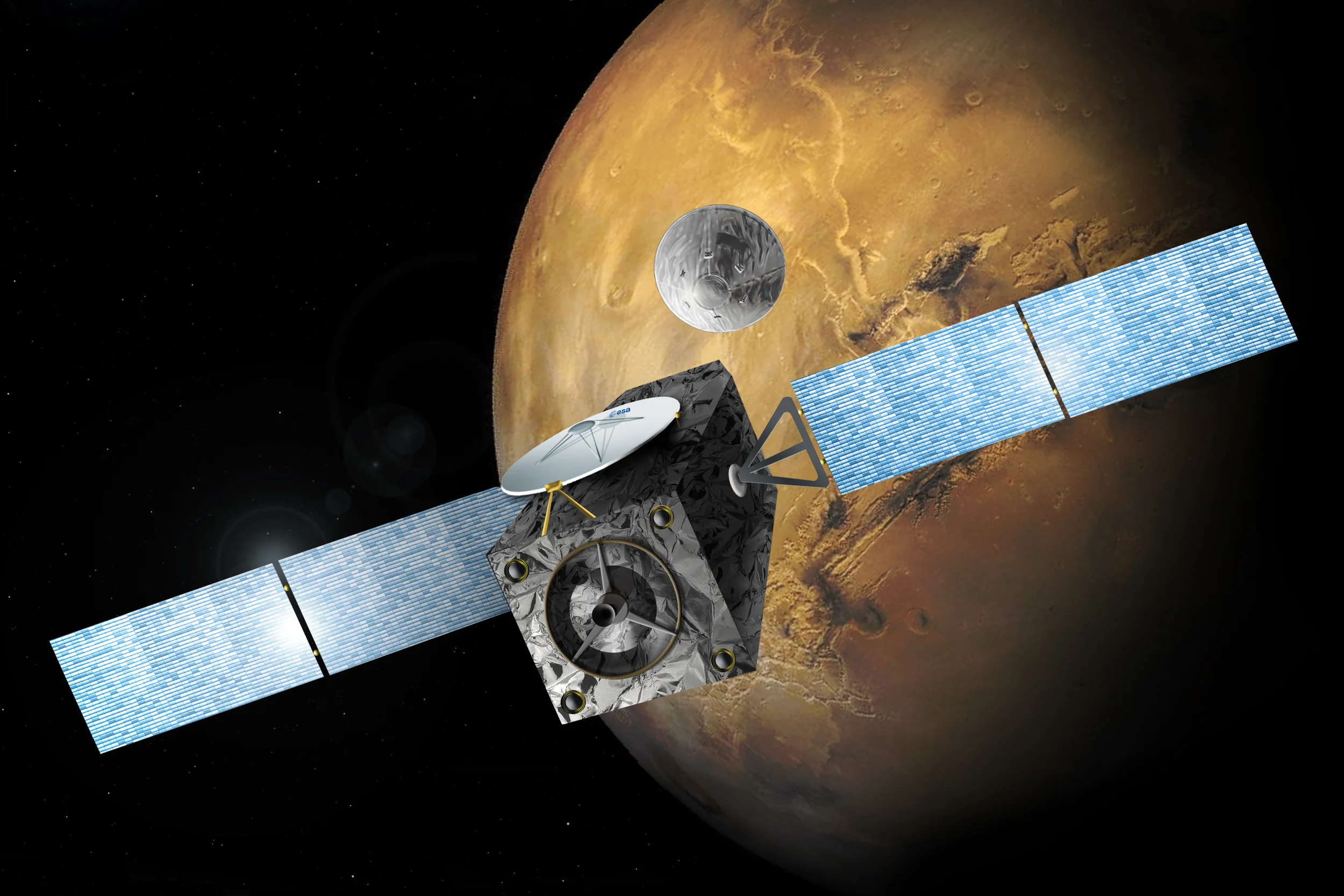A joint partnership between the European Space Agency (ESA) and the Russian Federal Space Agency (Roscosmos) officially began as the first of the ExoMars (Exobiology on Mars) missions launched earlier today (5:21am ET) from the Baikonur Cosmodrome. Propelled by a Russian Proton-M rocket, it will take the dual ExoMars payload seven-months to travel the 300-million-mile journey to the red planet.
Photo Credit: ESA
As part of humanity’s continued quest to determine if there is, or ever has been life on Mars, this first phase of the ExoMars missions is twofold; insert the Trace Gas Orbiter (TGO) into a stable Martian orbit, and land the Entry, Descent, and Landing Demonstrator Module (EDM) — named Schiaparelli — safely on the surface. The ultimate objective for the ExoMars program though, is to find and confirm the presence of methane.
Since 2003, localized traces of methane have been observed in Mars’s atmosphere at three specific places: Terra Sabae, Mili Fossae, and Syrtis Major — all of which show evidence of flowing water from the planet’s ancient past; leading to speculation that ice below the surface could provide a suitable habitat for microorganisms. The decomposition and breakdown of biological materials can produce methane, and accounts for up to 90% of the methane in Earth’s atmosphere. Though the traces observed on Mars have all been temporary, the gas’s presence could be an indication of past or present life on the red planet.
Image Credit: NASA
Studies of the Martian atmosphere won’t begin for some time, however. The Trace Gas Orbiter is scheduled to undergo a series of orbital maneuvers and aerobraking burns following its insertion into Mars orbit on October 16, 2016. In December 2016 the TGO will reduce its orbital period to 1-sol, and then, between January 2017 — November 2017, the TGO’s aerobraking phase will lower its altitude to a 400 km circular orbit. It is only then, in December 2017, that the probe’s science operations will begin, enabling the satellite to communicate not only with ESA and Roscosmos scientists back on Earth, but also with landers on the surface.
The Trace Gas Orbiter carries four separate scientific sensors. The Atmospheric Chemistry Suite (ACS) and the Nadir and Occultation for Mars Discovery (NOMAD), an infrared and ultraviolet spectrometer, will observe sunlight as it passes through the Martian atmosphere in order to better understand its composition. The Fine Resolution Epithermal Neutron Detector (FREND), modified to narrow the field-of-view of the instrument, will create high resolution maps of areas on Mars rich in the type of hydrogen content associated with the presence of water. Finally, a Color and Stereo Surface Imaging System (CaSSIS) will scout potential landing sites for the second phase of the ExoMars program - a rover planned for 2018.
Image Credit: ESA/ATG medialab
Designed to also serve as a support satellite for the upcoming ExoMars rover, the Trace Gas Orbiter will begin relaying communications data for the rover in January 2019, but is expected to last well into the year 2022.
Unlike its orbiting companion, the EDM Schiaparelli, named for the 19th century Italian astronomer Giovanni Schiaparelli (who’s birthday was the same date as the launch, coincidentally), will begin its mission as soon as it separates on October 16 of this year, and will have a much shorter life. With an internal battery expected to last only 2-8 sols and no way of generating additional power, the main objective of the Schiaparelli spacecraft is to test the technologies required to land the 2018 ExoMars rover.
Three days after separating from the Trace Gas Orbiter, Schiaparelli will enter the atmosphere at a speed of around 21,000 kph, vaporizing most of its heat shield as it falls from orbit. Compensating for Mars’s thin atmosphere, the spacecraft uses a combination of landing mechanisms to slow its descent. At about 11 km above the surface, Schiaparelli’s parachute will deploy, followed quickly by the jettison of its bottom-facing aeroshell shield. Slowing to about 250 kph, the parachute and top aeroshell will then be jettisoned as well, allowing the craft to fall free of its protective outer layer.
Radar on the spacecraft’s underside allows it to automatically measure its rate of fall and distance to the ground and, utilizing this information, Schiaparelli will fire its retro-thrusters to bring its speed under control. Slowing the craft into a brief hover at a height of about 2 meters, Schiaparelli will then disengage its thrusters and drop the short distance to the surface.
In its entirety, entry and descent through the atmosphere, and the landing sequence itself will take less than six minutes.
Image Credit: ESA/ATG medialab
Given a successful landing, Schiaparelli will make use of its 2-8 sol life expectancy with a small science payload onboard. Dust Characterization, Risk Assessment, and Environment Analyzer on the Martian Surface (DREAMS) will be used to measure local wind speed (MetWind), humidity (DREAMS-H), pressure (DREAMS-P), and temperature (MarsTem). The lander also contains a Solar Irradiance Sensor (SIS) and an Atmospheric Radiation and Electricity Sensor (MicroARES) for studying atmospheric transparency and electric fields.
Image Credit: ESA/ATG medialab
Continued study of the red planet is crucial to the efforts of not only the ESA and Roscosmos, but NASA as well, as they all prepare for the eventuality of sending humans, instead of robots, to Mars. The ExoMars satellites and landers will add to more than a dozen that preceded them, and the data they collect will put humanity that much closer to understanding our closest planetary neighbor in the solar system.










